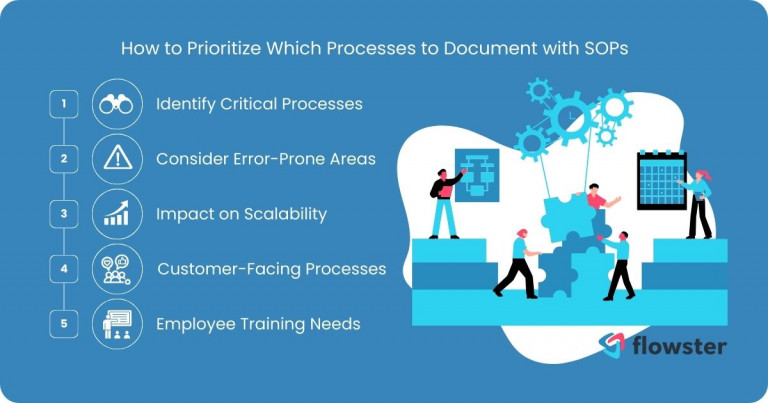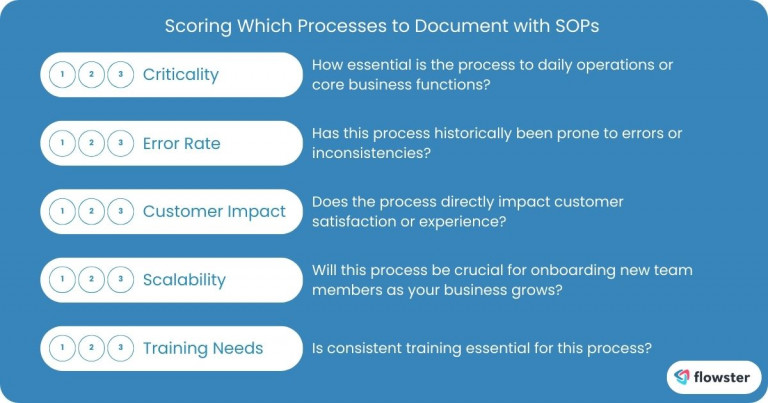Ever feel like your business runs on a wing and a prayer? You know the drill: scrambling to remember that one crucial step in the onboarding process, fielding customer inquiries about inconsistencies, or constantly retracing your steps because tasks haven’t been clearly documented. In the fast-paced world of small businesses and solo ventures, this lack of SOPs (standard operating procedures) can wreak havoc on efficiency and consistency.
The good news? SOPs are your secret weapon for streamlining operations. These documents capture the “how-to” of your business processes, ensuring everyone’s on the same page. Imagine a world where tasks flow smoothly, customer interactions are flawless, and new team members can hit the ground running—that’s the power of SOPs.
But with so many moving parts in your business, where do you even begin? The challenge lies in prioritizing which processes to document first. This guide will equip you with a clear strategy to tackle SOP development and unlock the full potential of your business.
Article Outline
How to Prioritize Which Processes to Document with SOPs
So, you’re ready to harness the power of SOPs but unsure where to begin? Here’s a strategic approach to prioritizing your SOP development and maximizing its impact on your business efficiency:
1. Identify Critical Processes:
Let’s start with the foundation. Critical processes are the lifeblood of your business—essential tasks completed daily or those with a significant impact on customer satisfaction and product quality. Documenting these first ensures a strong, well-oiled operational core.
Here are some examples of critical processes across various industries:
- E-commerce: Order processing, inventory management, product returns
- Freelance Writing: Client onboarding, research and writing procedures, invoicing
- Marketing Agency: Social media management, content creation workflow, client reporting
2. Consider Error-Prone Areas:
We’ve all been there—a crucial step gets missed, leading to mistakes and wasted time. SOPs act as a safety net by providing clear, step-by-step instructions. Focus your initial efforts on processes with a history of errors or inconsistencies. By documenting the correct way to do things, you can significantly minimize errors and streamline operations.
3. Impact on Scalability:
As your business grows, the smooth onboarding of new team members becomes crucial. SOPs are like a training manual in disguise, ensuring everyone gets up to speed quickly and consistently. Prioritize SOPs for processes that will be essential as you scale, setting your business up for long-term success.
4. Customer-Facing Processes:
Imagine a customer who is dissatisfied with the quality of the service. Yikes! Consistency is key to a positive customer experience. Document SOPs for processes that directly impact customer interactions, like order fulfillment, complaint handling, and customer support interactions. This ensures your team delivers a seamless experience every time.
5. Employee Training Needs:
Think of SOPs as built-in training tools. Whether onboarding new hires or refreshing existing staff knowledge, documented procedures ensure everyone is on the same page. Prioritize SOPs for processes where consistent training is crucial, saving you time and resources in the long run.
Now that you have a clear roadmap for prioritizing your SOP development, let’s dive into some practical tips for creating effective SOPs specifically tailored for small businesses. In the next section, we’ll explore strategies for crafting clear, concise, and user-friendly documents that empower your team and drive business growth.

Pro Tip! Prioritizing Which Processes to Document with SOPs
Feeling overwhelmed by the number of potential SOPs? Here’s a handy trick to help you objectively prioritize your SOP development: a scoring system!
Assign points to different factors that influence the importance of documenting a specific process. Here are some key factors to consider:
- Criticality: How essential is the process to daily operations or core business functions? (High = 3 points, Medium = 2 points, Low = 1 point)
- Error Rate: Has this process historically been prone to errors or inconsistencies? (High = 3 points, Medium = 2 points, Low = 1 point)
- Customer Impact: Does the process directly impact customer satisfaction or experience? (High = 3 points, Medium = 2 points, Low = 1 point)
- Scalability: Will this process be crucial for onboarding new team members as your business grows? (High = 3 points, Medium = 2 points, Low = 1 point)
- Training Needs: Is consistent training essential for this process? (High = 3 points, Medium = 2 points, Low = 1 point)
Example of Scoring a Process to Document with SOPs
Let’s say you’re a freelance writer. You might assign 3 points to “Client Onboarding” for criticality, 2 points to “Error Rate” (occasional typos), and 1 point each for “Customer Impact” (indirect), “Scalability” (not a huge team yet), and “Training Needs” (somewhat). This would give “Client Onboarding” a total score of 7, making it a high priority for your initial SOP development.
By assigning points and calculating a total score, you can make data-driven decisions about which SOPs will have the most significant impact on your business efficiency. Now, let’s wrap things up and explore some concluding thoughts.

Conclusion: Take Control and Conquer the Chaos with SOPs
Feeling empowered to tackle those undocumented processes? Remember, the key to prioritizing your SOP development lies in focusing on areas with the most significant impact on your business efficiency. Start by identifying critical processes, addressing error-prone tasks, and ensuring a smooth customer experience through documented procedures. Don’t forget to consider the importance of SOPs for future growth and staff training.
By taking these steps, you’ll be well on your way to a more streamlined and efficient operation. Ready to dive in and create your first SOP?
Flowster's AI-Driven Automation
Here’s an Easy Way to Document Your Processes
Flowster Marketplace offers a treasure trove of free resources to jumpstart your SOP development journey, including customizable SOP templates and various workflow templates. Streamline your operations further with our “Done-for-You” SOP creation services, allowing you to focus on what you do best—running your amazing business!




